|
|
|

Digital cameras, high-street prints and scanning
Film is an amazing material that has taken well over 100 years to reach its current
state. There's a huge amount of information packed into the shadows and highlights
on negative film. However, all that information can't be used in a straight-forward
print from the negative or in a pic on a website, because it would just look too
'flat' and lacking in contrast. So, something, somewhere has to go...
 |
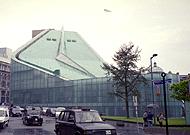
^ With a scan of a colour negative we can increase the contrast of the pic, so
the foreground looks good.
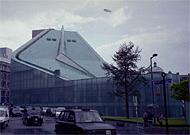
^ Or we can darken it to show the clouds in the sky.
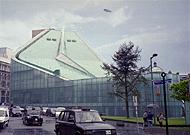
^ Best of all, we can do a mixture of the two. So we get a good-looking foregound
and detail in the sky. This isn't possible to the same extent with a photo
from a digital camera, because the same range of picture information isn't there...
One way around this with digital, is to take two shots -- with different exposures
--and then combine sections of the two. |
|
If you're working with the negative yourself -- in a darkroom or on a computer
screen -- you can choose what you want to lose. You might preserve the highlights
and drop some of the shadow details, concentrate on the shadows and loose highlights,
or some mixture of the two. You could even boost or surpress just certain areas
(for example, to darken only the sky so the clouds show up).
However, its a different story when you send your colour negative film away to
a lab. There, these decisions are usually taken by a machine, which tends to average
everything. However, some labs are better than others...
I sent some films to Truprint and got the prints back today. Admittedly this is
a cut-price service. Really I only wanted to get the negatives processed and wasn't
too bothered about the prints (labs are much the same as far as the negative-processing
is concerned). Of course, I received prints back too and, even though I wasn't
expecting much, I was surprised by just how bad they were.
In fact it was quite depressing to look through them and a relief when I began
to scan the negs and realised I did have some good shots after all! Most
people just assume that their too-dark or over-light prints are due to something
they did wrong!
Here are some examples from the prints I just got back. Firstly, a photo that
I took of a Commonwealth Games banner just above a tunnel. This is a difficult
subject for the print machine at the lab due to the large areas of shadow.
Here's a scan I made from the negative...
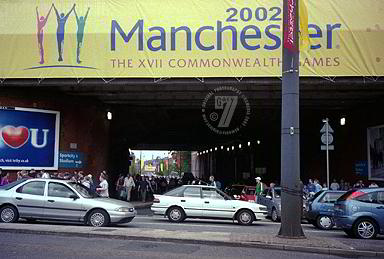
Now here's how Truprint thinks it should look. This is a straight scan from their
print...
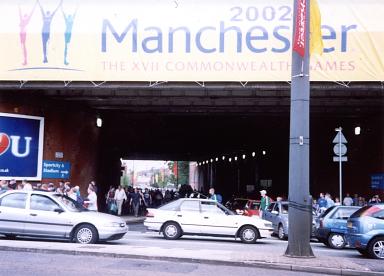
'That's really bad isn't it? Less 'difficult' negs aren't quite so grim... Below
left: print. Below right: my neg scan.
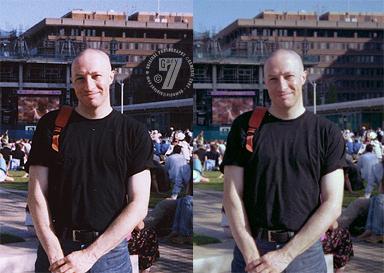
Once that shadow or highlight detail has been lost in a print, you can never get
it back when scanning the print. And, as far as sharpness is concerned, you'll
always get a sharper result by scanning a negative rather than a print, simply
because the print is a copy and quality is lost in making it. In fact, I've been
told colour print paper only has a resolution of around 200 dots per inch.
The average person doesn't have a film/negative scanner, they have a flatbed and
they have no alternative but to scan from prints. If their prints are as bad as
some of the ones I just had back, they don't have a hope in hell of getting good
scans from them...
It's no wonder people are moving over to digital cameras...
The digital camera also produces sparkling contrasty images and, once again, it
does this by dropping some of the shadow and/or highlights that are present in
the scene. Although there is a little scope for tweaking shadows detail later,
there's nowhere near the information to work with as there is in a negative...
In that respect, digital is more like slide film.
But at least the photographer can see what he or she is getting at the time of
shooting, thanks to the digital camera's electronic viewfinder.
I'm sure I'll get myself a more expensive digital camera in the future but, for
the moment, I'm quite keen to stick with colour negative film.


Click here to visit the Badpuppy website
GETTING IN TOUCH

See the contact
page for full details of how you can reach me by e-mail or chat.

All content is
�copy; Copyright GarySevenUK.com 1999-2006.
Read more here
|
|